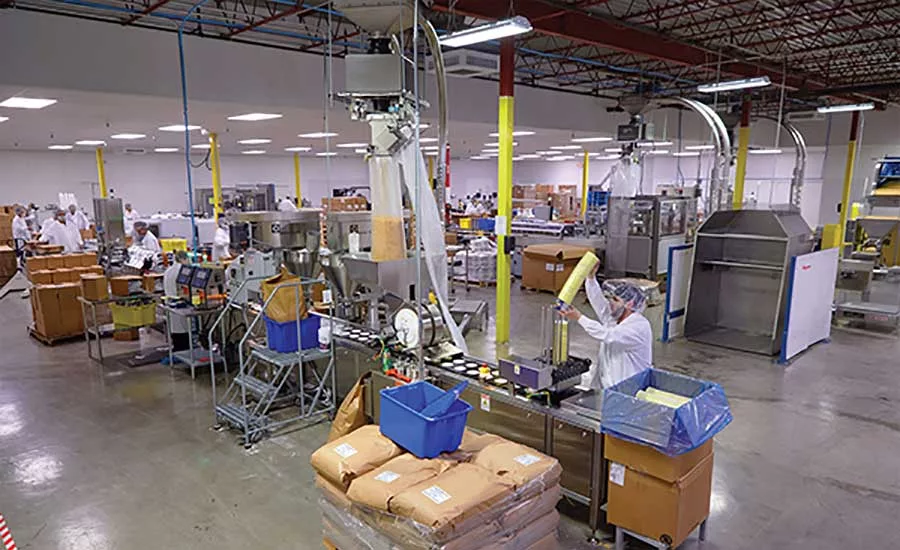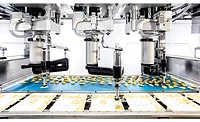Dry Processing
Quality Pasta, Flexicon work together to reduce breakage
Open-chute dumpers and a conveyor system cut down on breakage and dust.

Open-box dumpers from Flexicon Corp. unload pasta from Gaylord containers. The pasta is then moved by tubular cable conveyors to minimize breakage and dust. Source: Quality Pasta Company.

A production line at Quality Pasta Company. Dumpers and conveyors from Flexicon Corp. help the company quickly move pasta from bulk boxes to retail packaging with minimal breakage and dust. Source: Quality Pasta Company.
Quality Pasta Company sells seven branded pasta products in noodle, shell and macaroni form. Offerings include high-protein macaroni and cheese, shells and cheese lines and a microwaveable macaroni and cheese cup.
Most of the products, about 95 percent, are sold to retailers, and the rest are for institutional users.
Pasta arrives at the plant in Gaylord containers—double- or triple-wall corrugated bulk boxes—that weigh 800 to 1,300 lb. After quality assurance inspection and weighing of the containers, the material is stored until ready for packaging.
But the company needed a way to move brittle pasta at high rates from the Gaylord containers to three packaging lines without product breakage or dust.
“Consumers are knowledgeable about product quality and do not want to see breakage in the pasta they buy,” says Todd Kish, operations manager.
He explains that many competitors load pasta into hoppers with plastic shovels for discharge to conveying lines. But that process is labor intensive and can increase breakage.
To find a way to cut down the breakage, the company worked with Flexicon Corp. to install two open-chute box dumpers and three Flexi-Disc tubular cable conveyor (TCC) circuits, in which low-friction polymer discs attached to a stainless steel cable gently slide the pasta through smooth stainless steel tubing.
“The TCCs transport pasta with a breakage rate of less than 1 percent,” Kish says.
Also, the TCC is an enclosed system, so it prevents the release of dust and other particulates into the sanitary packaging area.
The two open-chute box dumpers automatically raise and tilt the Gaylords, which discharge pasta into 8-cu.-ft. hoppers. Pasta discharges from the hoppers onto vibratory tray feeders that control the rate at which material flows into the inlet adapter of each conveyor.
A proximity level switch connected to an indicator light in the PLC control panel alerts operators to low material levels in the large hopper.
One box dumper additionally serves the cup pasta line.
“The cup pasta is fragile, and we only package 2,000 pounds of the product per day,” says Kish. Using two dumpers for three lines also leaves more floor space for operation, he adds.
Each 4-in. diameter TCC circuit runs in an “S” shape, starting horizontally, rising eight ft. vertically and continuing two ft. horizontally, ending at a drive wheel discharge housing, from which material flows through a metal detector and into a packaging machine hopper. The vertical leg includes two 3-ft. transparent sections for operators to visually monitor performance of the system.
The cable-disc assembly’s direction of travel is reversed at the discharge end of the circuit by the drive wheel and at the intake end of the circuit by a tensioning wheel that keeps the cable taut throughout the system.
Because the tubular cable conveyors fully evacuate material, cleaning and product changeover can be accomplished in 15 to 20 minutes, says Kish. During changeovers, workers clean the TCC lines with antibacterial swabs and flexible sponges.
Quality Pasta also employs a portable, caster-mounted 15-ft.-long, 4.5-in. diameter flexible screw conveyor with a 5.5-cu.-ft. capacity hopper to transport powdered cheese for packet packaging and inclusion in some product boxes. The hopper includes a tray support for manually emptying bags and is designed for poorly flowing materials. Between the conveyor discharge and packaging machine, material passes through a metal detector.
The inner screw of the conveyor is the only moving part contacting the powdered cheese and is driven above the point at which it exits the conveyor, preventing material contact with bearings or seals. The spiral is specially designed to move non-free-flowing materials, such as cheese powder.
Portability is important for the “cheeser” line sanitary conveyor, Kish explains, because it is removed from the cheese room for regular cleaning of the inner spiral, as well as for kosher cleaning.
For more information:
Flexicon Corporation, 888-353-9426,
sales@flexicon.com, www.flexicon.com.
Looking for a reprint of this article?
From high-res PDFs to custom plaques, order your copy today!







